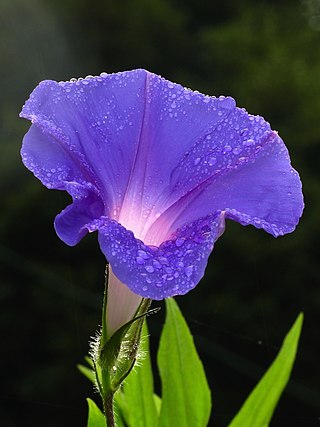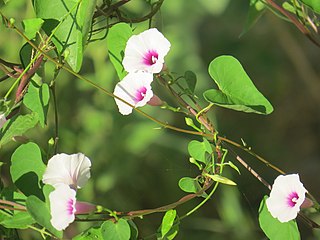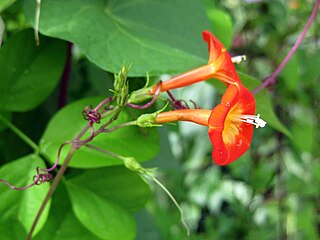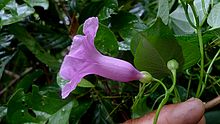
Convolvulaceae, commonly called the bindweeds or morning glories, is a family of about 60 genera and more than 1,650 species. These species are primarily herbaceous vines, but also include trees, shrubs and herbs. The tubers of several species are edible, the best known of which is the sweet potato.

Morning glory is the common name for over 1,000 species of flowering plants in the family Convolvulaceae, whose current taxonomy and systematics are in flux. Morning glory species belong to many genera, some of which are:

Ipomoea quamoclit, commonly known as cypress vine, cypress vine morning glory, cardinal creeper, cardinal vine, star glory, star of Bethlehem or hummingbird vine, is a species of vine in the family Convolvulaceae native to tropical regions of the Americas and naturalized elsewhere in the tropics.

Ipomoea pes-caprae, also known as bayhops, bay-hops, beach morning glory or goat's foot, is a common pantropical creeping vine belonging to the family Convolvulaceae. It grows on the upper parts of beaches and endures salted air. It is one of the most common and most widely distributed salt tolerant plants and provides one of the best known examples of oceanic dispersal. Its seeds float and are unaffected by salt water.

Ipomoea cairica is a vining, herbaceous, perennial plant with palmate leaves and large, showy white to lavender flowers. A species of morning glory, it has many common names, including mile-a-minute vine, Messina creeper, Cairo morning glory, coast morning glory and railroad creeper. The species name cairica translates to "from Cairo", the city where this species was first collected.

Ipomoea tuberculata is a flowering plant species in the bindweed family (Convolvulaceae). It belongs to the morning glory genus, Ipomoea.

Ipomoea lobata, the fire vine, firecracker vine or Spanish flag, is a species of flowering plant in the family Convolvulaceae, native to Mexico and Brazil.

Ipomoea indica is a species of flowering plant in the family Convolvulaceae, known by several common names, including blue morning glory, oceanblue morning glory, koali awa, and blue dawn flower. It bears heart-shaped or 3-lobed leaves and purple or blue funnel-shaped flowers 6–8 cm (2–3 in) in diameter, from spring to autumn. The flowers produced by the plant are hermaphroditic. This plant has gained the Royal Horticultural Society's Award of Garden Merit.
Ipomoea chrysocalyx is a vine in the family Convolvulaceae. It is endemic to Ecuador. Its natural habitat is subtropical or tropical dry forests.
Ipomoea pulcherrima is a species of plant in the family Convolvulaceae. It is endemic to Peru.

Ipomoea hederacea, the ivy-leaved morning glory, is a flowering plant in the bindweed family. The species is native to tropical parts of the Americas, and has more recently been introduced to North America. It now occurs there from Arizona to Florida and north to Ontario and North Dakota. Like most members of the family, it is a climbing vine with alternate leaves on twining stems. The flowers are blue to rose-purple with a white inner throat and emerge in summer and continue until late fall. The leaves are typically three-lobed, but sometimes may be five-lobed or entire. Flowers occur in clusters of one to three and are 2.5-4.5 cm long and wide. The sepals taper to long, recurved tips and measure 12–24 mm long. The species shares some features with the close relative Ipomoea purpurea.
Ipomoea abrupta is a species of plant in the family Convolvulaceae of the genus Ipomoea. It is endemic to Western Australia.

Ipomoea asarifolia, the ginger-leaf morning-glory, is a species of plant in the family Convolvulaceae, of the genus Ipomoea.

Ipomoea amnicola is a species of plant in the bindweed family, Convolvulaceae. It is commonly called redcenter morning-glory. It is found in Mexico, much of South America and has been successfully introduced in the US states of Arkansas, Missouri and Texas.

Ipomoea leptophylla, the bush morning glory, bush moonflower or manroot, is a flowering plant species in the bindweed family, Convolvulaceae.

Ipomoea coccinea is a flowering plant in the family Convolvulaceae known by several common names including red morning glory, redstar and (ambiguously) Mexican morning glory.

Ipomoea tastensis is a species of plant in the bindweed family, Convolvulaceae. It is native to the Mexican state of Baja California Sur and are particularly abundant in the Sierra El Taste, where the white showy flowers make them a conspicuous part of the landscape.

Ipomoea sagittata, commonly called the saltmarsh morning glory, is a species of flowering plant in the morning glory family. It is native to the Caribbean, Mexico, and the Southeastern United States where it is found in coastal areas. It has been introduced in the Mediterranean Basin at least since the 17th century as a result of seeds transported in ship ballast soil, the ornamental trade or its uses in medicine. This species can be found in the wild in thickets on barrier islands, the edges of salt marshes, and in hammocks.

Ipomoea bracteata is a species of plant in the bindweed family Convolvulaceae. It is endemic to Mexico.
Ipomoea kahloae is a species of flowering plant in the morning glory genus Ipomoea, family Convolvulaceae, native to the state of Guerrero, Mexico. Known from only a few localities in semi-deciduous tropical forests, it has a number of distinctive features, including stems and petioles with pronounced wings, and magenta corollas.
















